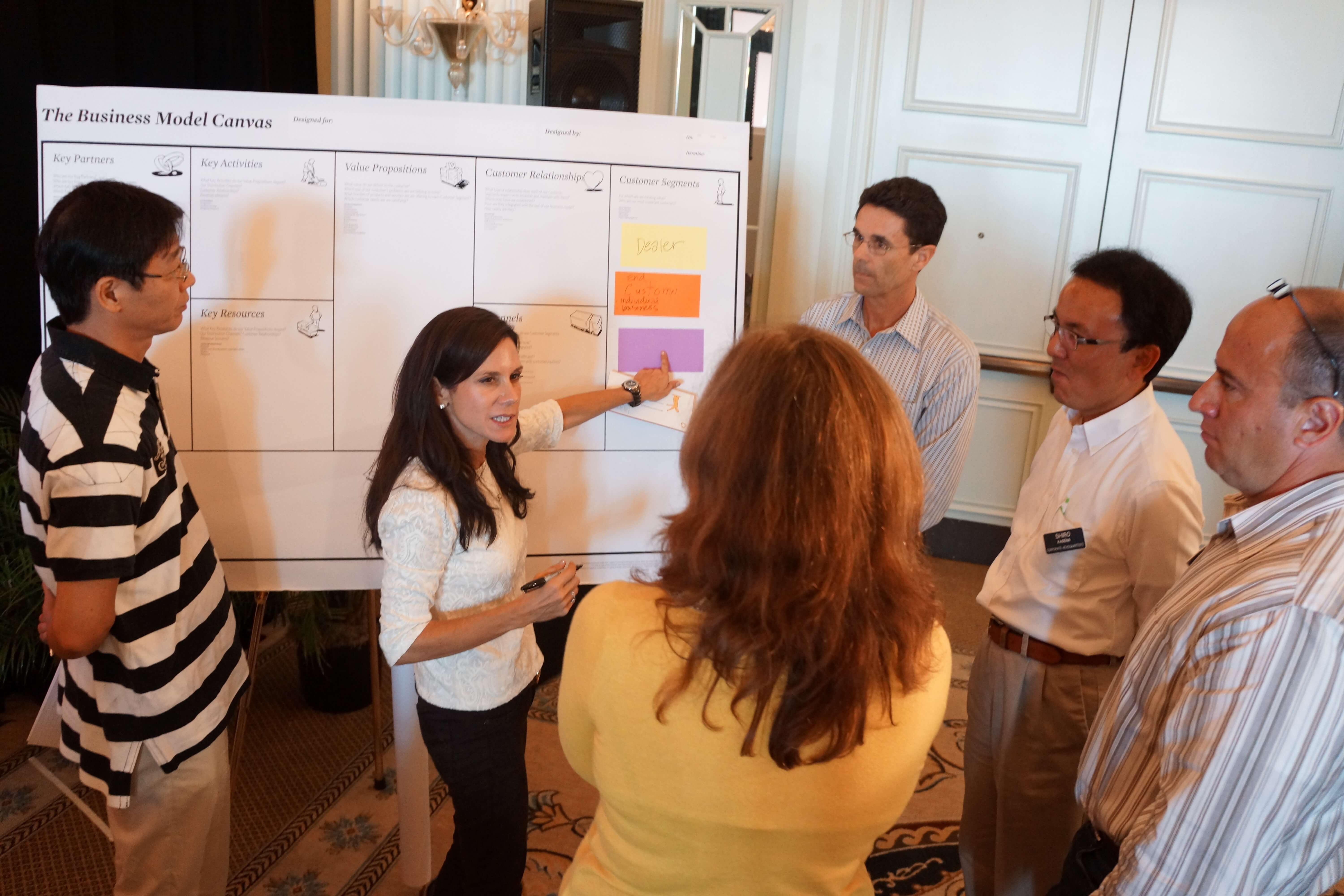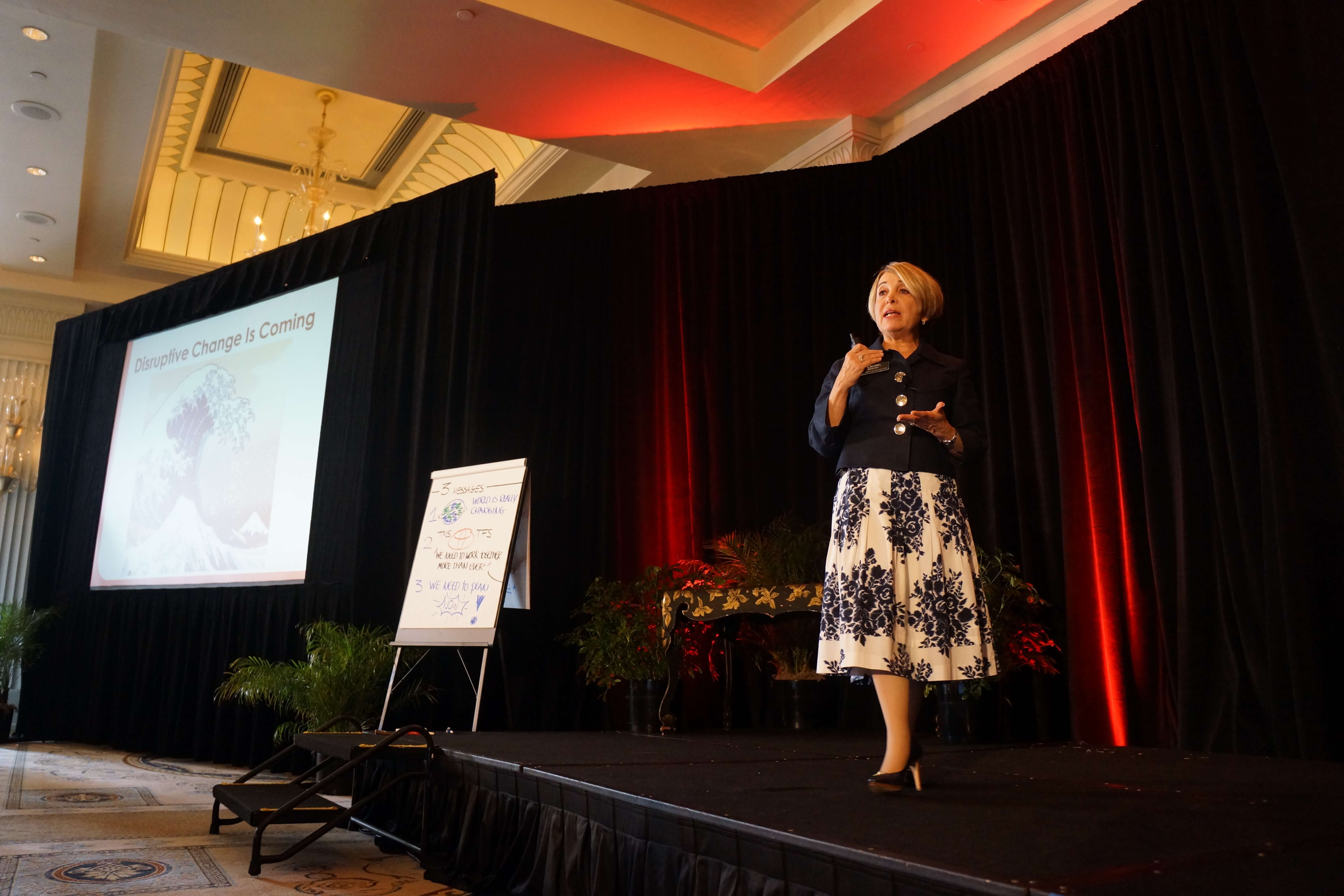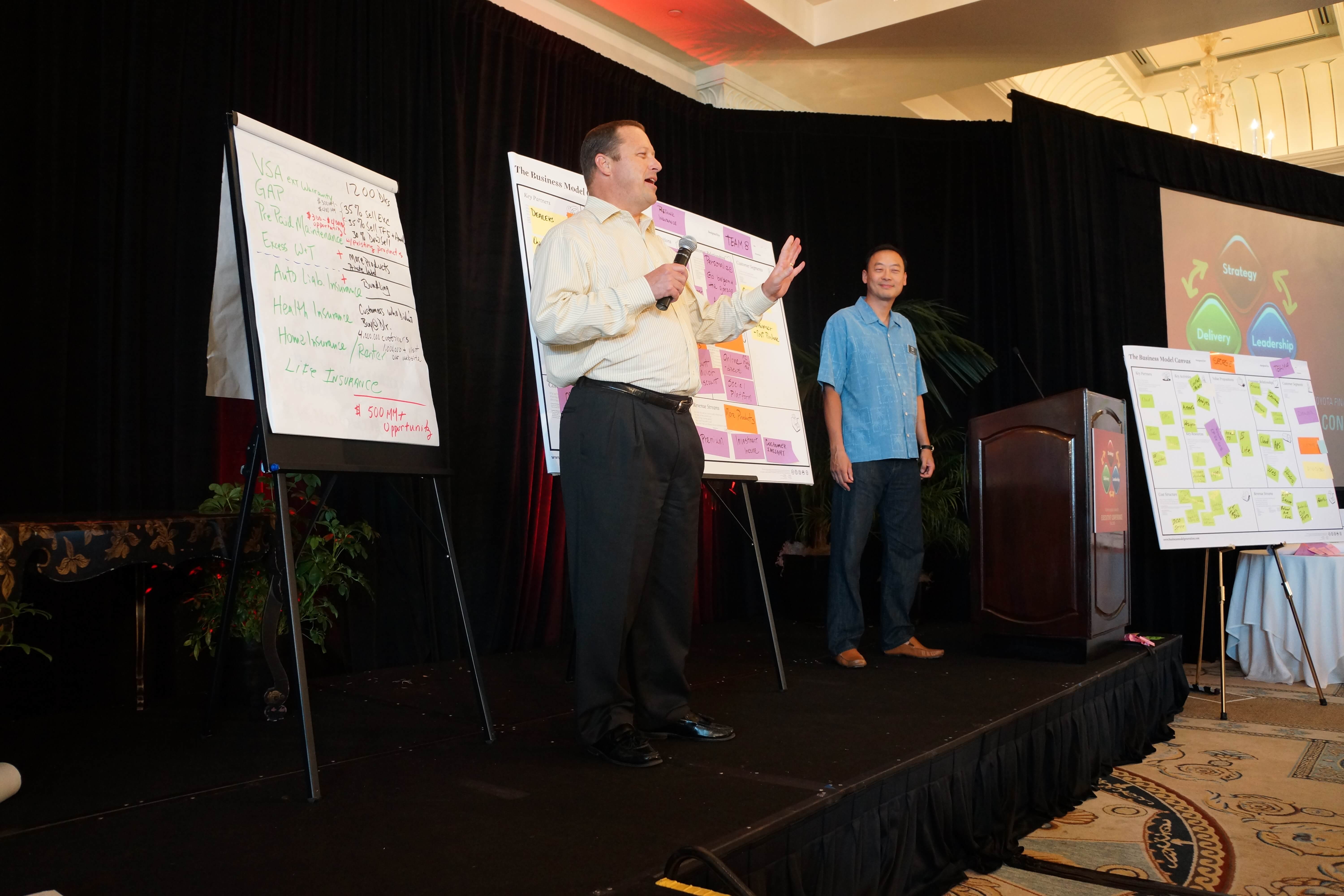In 2012 Toyota Financial Services (TFS), the finance subsidiary of the Toyota Motor Corporation, was under a lot of pressure. The parent company had recently experienced a substantial number of automotive recalls, the external business environment was transforming, and TFS was struggling with internal political and cultural issues. To make matters worse, the CEO was preparing to set the bar impossibly high for his executive team at an upcoming strategic planning off-site. He was going to ask the company to double profits in five years without increasing spending.
"George Borst, our CEO at the time, had set a profit goal for us to achieve by 2017. As we studied that number we knew we could not get there doing business as usual.”
Lisa Chen
TFS Finance Strategy Manager
Borst put Ann Bybee, TFS’s Vice President of Strategic Planning, in charge of designing a two-and-a-half-day strategic conversation. Bybee and her committee wanted the session to be collaborative and engaging but also focused around the goal of increasing profits. The group knew they needed to prepare something that would help participants to both visualize the challenge and equip them to design the business of the future.
In the past, many intelligent people at TFS had tried to take a future focus, but TFS' traditional processes and tools consistently failed them when they tried to come up with new disruptive opportunities. As one person put it, "There was a curse of knowledge with plans on top of plans, spreadsheets on top of spreadsheets, metrics on top of metrics, scorecards on top of scorecards; a lot of business plans, and everything [had to] come from a trend report". The committee knew that TFS' traditional methods of innovation would not be enough to move the company towards its future goal of doubled profits.
While the rest of TFS had been warmed up to visual tools they hadn't really worked with them enough to collaborate and co-create something. Lisa Chen, TFS' Finance Strategy Manager and a member of the planning committee had some previous experience with the Business Model Canvas. She felt it was a tool the organization could use to build a discussion around reinventing the company's business model. Chen knew it would be a massive effort to get the rest of the executive team engaged. She and the rest of the planning committee immediately began preparing the sessions for the executive off-site.
Preparing for the off-site
Because the organization was so new to the tool and concepts, the committee enlisted outside help to ensure success for the task ahead. They brought in Lisa Kay Solomon who had a long history of consulting with Toyota Financial Services and had previously helped in a similar type of strategic workshop. The committee also brought in Patrick van der Pijl who had extensive practical experience using the Business Model Canvas. van der Pijl had helped produce the Business Model Generation book and uses the Business Model Canvas extensively in his consultancy, Business Models Inc.
The committee along with Solomon and van der Pijl wanted to test whether or not using Strategyzer's tools with the executive team at the off-site would even work. They decided to do a pre-workshop session with a small group of key leaders from a few business units. This small group spent a day and a half creating Business Model and Value Proposition Canvases depicting the current state of TFS and its customers.
Leaders completely bought into the framework because of how easy it made the conversation.”
Lisa Kay Solomon
The committee also learned during the pre-workshop that there was a lack of agreement and understanding of the current business model, even within leadership. This was creating a lack of unity within the executive team around what the company's strategy needed to be going forward.

The committee also wanted to get a feel for how the executive team wanted to grow the business over the next five years across the following dimensions: increasing revenues, optimizing resources, and managing costs. They got the executive team thinking and ideating around these dimensions by asking them to submit new ideas through an internal web portal. The committee did everything they could to remove barriers and provide incentives for executives to submit objective ideas. Over 60 new ideas surfaced through these discussions. Those ideas fell into four main themes for how TFS could grow its business:
- Refine its insurance offering
- Become the financial brand of choice for consumers
- Cut operational expenditures by half
- Surprise its dealerships with totally new products and services
With four main areas where the executive team could focus its innovation efforts, the committee now felt confident in their plans for the off-site. The session was a big success and helped to bring clarity for the challenges ahead.
The Off-site
From October 3-5, 2012, fifty-five of TFS' top executives and managers came together in Santa Monica, CA for a 2 1/2 day strategic planning workshop. There were high hopes from the planning committee that the team would come away with a better understanding of the company's future business models.
Day 1:
Borst opened the off-site by introducing the new goal to all attendees. A few other executives presented some context around the existing challenges and pressures facing TFS. Borst then turned the remainder of the off-site over to the committee to run the planned business model innovation workshop.
The committee had two primary objectives for getting things started. First, they needed to familiarize the entire group with the tools. To accomplish this, the committee had everyone practice mapping out a business model they were familiar with. Second, the committee needed to help the group realize that there was a lot of misunderstanding and misalignment around the current business model.
To do this, Solomon and van der Pijl split the executive group into smaller cross functional collaborative teams. Each team had a mixture of executives, management committee members, and employees from different parts of the business ensuring that different perspectives were brought to the table. Each team was given a canvas and assigned to put together a current state business model.

An incredible breakthrough occurred as each team began building their business models. The group realized they lacked consensus on who TFS' primary customers were. Borst put some urgency on the matter while Solomon and van der Pijl used the Value Proposition Canvas to help the group push forward and focus on three specific customers: two external, dealers and end-consumers, and one internal, Toyota Motor Sales. This would not have happened without the visual tools forcing the group to ask and respond to the questions presented by the Canvases.
With a common understanding of the current state of the business model and which customers TFS needed to focus on, Solomon and van der Pijl then revealed the 60+ ideas from the ideation portal. They mapped the ideas against the canvas making it very clear to the group that the ideas and initiatives generated fell squarely on the left hand side of the canvas (infrastructure side) but didn't do a whole lot to improve the right hand side (value side) of the canvas. There was too strong of a focus on cost cutting with very little focus on real value creation for customers and for the company. Solomon and van der Pijl also helped the group to visualize the real size of their ideas. The majority of the ideas only resulted in small, incremental improvements having very little impact on revenues or even on costs.
The first day was a real eye opener for everybody. As Solomon put it, "There’s nowhere to hide and there is no more lobbying when the facts are on the wall."
Day 2:
The next day Solomon and van der Pijl help the teams generate new business models that would get TFS closer to its goal. They used a series of "What If" questions as well as the four themes that had emerged from the ideation portal as a foundation for designing the new business models. The teams went through a series of ideation and innovation exercises with Solomon and van der Pijl challenging teams on their models and encouraging them to think bigger and differently. The teams were also required to make sure that the left and right sides of each of their canvases were more thoughtfully tied together around creating, delivering and capturing value.
Close to the end of the day, each team selected their best idea for a new future business model. Each team then presented their ideas on stage and told their peers what they liked and disliked about the new model that they had created. The audience then had a chance to rate each idea as if they were the CEO allocating funds only to the models that would result in doubling profits.
By the end of the second day the group had conceived four, very concrete models for moving the company forward across the four themes.
Day 3:
On the third day the teams took the outputs from the current and newly formed future state canvases to conduct a simple gap analysis. The canvases illuminated exactly where TFS needed to focus its resources and investments. TFS could now also build the necessary capabilities to close the gaps between current and future state business models. The teams then created actionable execution plans and a three year roadmap for implementing their new strategic plans. Ownership and accountability was also assigned and established for critical executives and managers to take these projects forward after the off-site.
This time, we made the ideas concrete before we left and knew how we were going to take them forward. We had no shortage of volunteers who wanted to work on it in some way. I’ve never had that happen before.”
Chris Ballinger
CFO
Borst closed up the off-site by endorsing it and the new tools in a very real way. He emphasized that the off-site was not pie in the sky and that this work had to continue on a regular basis in order for TFS to get to where it needed to go. He went on record saying that his job was to enable the executive team and managers to continue doing the work that was done during the off-site as their new day jobs.
At the end of the off-site, everybody from the CEO on down was aligned around their new strategic goal and around their newly conceived plan for getting there.
Beyond the Off-site
The new business models created at the off-site became the true north for TFS' other plans and investment roadmaps. Executives and managers have now aligned different business units to the new models and have aligned other tasks that are going on in the company with certain building blocks in their canvases. Some of the executives now require their teams to develop new business strategies and funding requests using the Business Model Canvas as their foundation. The Canvas has also become the basis for conversations between internal business groups and partners as well as for long term business unit planning.
Conclusion
The Business Model Canvas has become a strategic communication and alignment tool for TFS' executive team. The team now has tools that it can actually use to get a lot done in a very short period of time. Executives and managers have actually adopted those tools and have created a new way of working. Everybody is now speaking the same language and is socialized around a framework that allows strategic conversations to push forward in a much more effective way. Any member of the executive team can now see a business requirement from the top and visualize how it will be delivered all the way down at the bottom.
Do you have a great story of how your organization has adopted and used Strategyzer tools and methods?
Credits: Detailed interviews were conducted with Lisa Chen (TFS), Patrick van der Pijl (Business Models Inc.), and Lisa Kay Solomon. Images courtesy of Patrick van der Pijl. An alternate version of this case can be found at Business Models Inc. and in Solomon's book, Moments of Impact.

Create growth or learn at scale
We can show your company how to use our methodology to understand customers, leverage your assets, and grow. See our enterprise programs to help you achieve strategy and innovation success.

